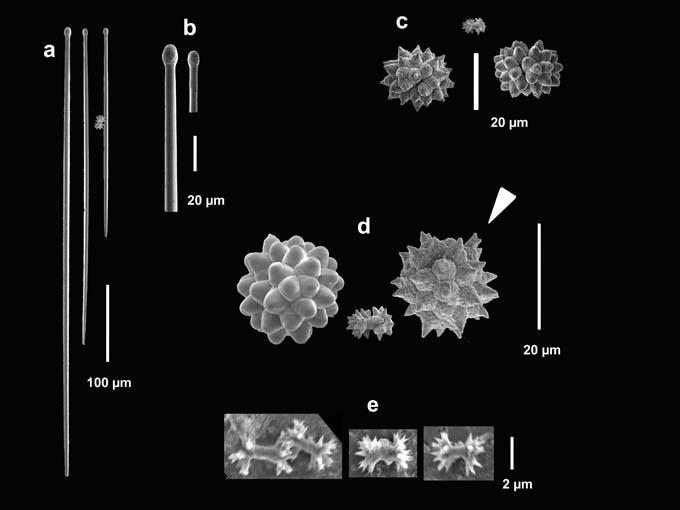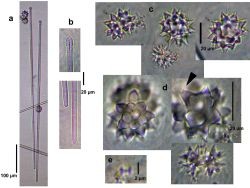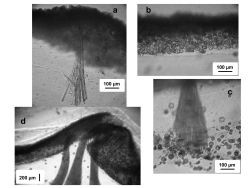red
orange
encrusting
tough
Bahamas
Placospherastra micraster
Description: Thickly encrusting, up to about 0.5 mm thick and about 20 cm in diameter. Surface is made up of a tough and leathery cortex, pierced by rounded to elongated furrows with slightly elevated borders (ridges); furrows are generally not connected to each other, although they may form a maze, from which portions may constitute separate plates; oscules round and large, up to about 5 mm in diameter, interspersed throughout the surface among the furrows (sometimes surrounded by them), with slightly elevated collars. Color bright red or orange. Consistency leathery, tough to tear and cut. Skeleton as a cortex of tightly-packed spheraster spicules (up to 5 spicules thick), supported by rather sparse thick vertical tracts of tylostyle spicules, ut to about 150-200 µm wide; tracts act like pillars and seem to be grouped along the furrow borders; between pillars, the tissue is almost devoid of spicules. At the base, there is a layer of spherasters, more scattered than at the cortex, embedded in what appears to be an organic matrix. Megasclere spicules are tylostyles with a rather narrow head, often a wrinkled neck, and blunt ends, 260-610 µm long by 4.7-7 µm wide; an axial canal is highly visible. Microscleres of two types: (1) spherasters, slightly oblong, with wide and short, smooth spines, ending in one, sometimes two, nipple-like tips, 18-35 µm in maximum diameter; they seem to be derived from diplasters, which appear as a small developmental stage, with rugged surface under SEM; (2) small asters (micrasters, micramphiasters, microspirasters), ca. 2 µm in diameter, barely visible under the light microscope, with two or three rays, each ornamented by a bouquet of spines.
Notes: This species lives in vertical to overhanging, but often illuminated deep reef substrata. It was erroneously called Diplastrella megastellata (Hechtel, 1965) by Pawlik et al. (2005), which is a good, different species, also pictured here. Our material conforms to two recently described species, Timea micraster Lehnert & Heimler, 2001 and Placospherastra antillensis van Soest, 2009. The two species have practically the same skeleton, with slight variations that seem to be due to the differences in emphasis made according to the genera they were placed into when described. While the types are compared among them and with our material, we have decided to use the oldest species name with the new generic assignment, hence Placospherastra micraster. The very thick and leathery cortex of this species is unlike what has been defined for the genus Timea (family Timeidae, order Hadromerida, see Rützler, 2002b). van Soest (2009) noted polygonal armor-like plates in this species, and as they are characteristic of the genus Placospongia (family Placospongiidae, Order Hadromerida, see Rützler, 2002a), but in this case are made of spherasters instead of selenasters, he erected a new genus, Placospherastra. In life, our material and in T. micraster these plates are not as evident as they are in species of the genus Placospongia, even when the furrows appeared shrunk. However, van Soest (1990) mentioned that furrows-ridges are often maze-like, seldom surrounding entirely a plate, as is the case in our photographed individuals (and in Placospongia species, for that matter). Unfortunately, we only collected small fragments and in the field failed to check closely for fully separated plates. From light microscopy alone and a few SEM images obtained, we have not been able to confirm the presence of rings of small spines ornamenting the main spines of the spherasters, as described for P. antillensis (see van Soest, 2009).
Author Reference: (Lehnert & Heimler, 2001)
Link: World Porifera Database

![<i>Placospherastra micraster</i> <br />[Bahamas, Egg Island]](mini/00121/00716.jpg)
![<i>Placospherastra micraster</i> <br />[Bahamas, Sweetings Cay]](mini/00121/00776.jpg)


